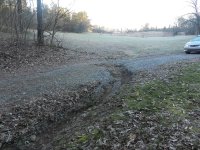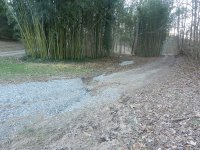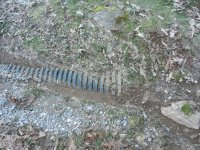Richard
Super Member
- Joined
- Apr 6, 2000
- Messages
- 5,009
- Location
- Knoxville, TN
- Tractor
- International 1066 Full sized JCB Loader/Backhoe and a John Deere 430 to mow with
I've not read everything yet. I butchered some of the typo's in my comment and title!
Anyways, I do have an industrial backhoe (JCB). It's got a 2' bucket on the end.
This is essentially our driveway with an occasional delivery truck. The timber trucks were obviously not typical.
We have two ways in/out of here and the wife uses the other. I tend to use this one as it goes by the dock so I can see what's going on out here from start to finish.
The field above this will collect a lot of water during a hard rain. I'll see if I can attach a picture of the field. I don't know that this part of the driveway will show. (turns out it doesn't)
This is the field that collects and aims right to the road, washing it out.
If I recall, it seems our neighbor has a concrete culvert left over from his construction. Might be too big. I'll bet he'd love to get rid of it. Might also be too short.
What is a good size?
If I can try to describe the area....this field slopes towards the lake. It's fairly flat. I don't have a natural slope where I can dig down 5' and install something. I'm balancing opposing forces of trying to install a large pipe in an otherwise flat area and not creating a hump in the road or, digging it so deep I have dirt covering half the opening.
I'll admit I've never installed a culvert nor pulled one out as we're going to have to do. This will be a learning experience.
I'll try to get a better picture.
Anyways, I do have an industrial backhoe (JCB). It's got a 2' bucket on the end.
This is essentially our driveway with an occasional delivery truck. The timber trucks were obviously not typical.
We have two ways in/out of here and the wife uses the other. I tend to use this one as it goes by the dock so I can see what's going on out here from start to finish.
The field above this will collect a lot of water during a hard rain. I'll see if I can attach a picture of the field. I don't know that this part of the driveway will show. (turns out it doesn't)
This is the field that collects and aims right to the road, washing it out.
If I recall, it seems our neighbor has a concrete culvert left over from his construction. Might be too big. I'll bet he'd love to get rid of it. Might also be too short.
What is a good size?
If I can try to describe the area....this field slopes towards the lake. It's fairly flat. I don't have a natural slope where I can dig down 5' and install something. I'm balancing opposing forces of trying to install a large pipe in an otherwise flat area and not creating a hump in the road or, digging it so deep I have dirt covering half the opening.
I'll admit I've never installed a culvert nor pulled one out as we're going to have to do. This will be a learning experience.
I'll try to get a better picture.





